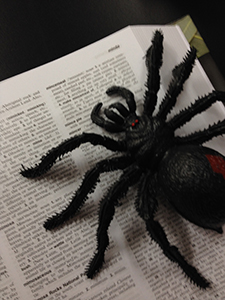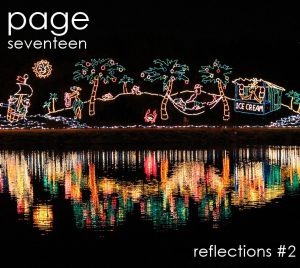

Blog
Welcome to the Busybird blog, where you can find helpful articles, updates, industry news and more. Make sure you stay up to date by signing up to our newsletter below.
Working on the Other Side of the Globe
October 16, 2014
One year ago my teacher told me to apply for work experience because everyone in Germany has to work for a few weeks at a company to gain some experience. I wanted to do my work experience in a foreign country and thought of living with the cousin of my dad, who moved to Melbourne twenty-six years ago. My first intention was to work for a radio station or a television channel but when they chose someone different I needed an alternative. By reason I’m thinking of working as a journalist after I finish school, I decided to apply at a publishing company and ended up at Busybird.
One year later, after twenty-four hours of plane food and sleepiness, I finally arrived in Melbourne on a Saturday evening. The plane flew half an hour over the city and all the lights were shining. That was the first time I realised that Melbourne is bigger than I could have ever imagined and that this city never sleeps.
After I finally got my suitcase, passengers of three flights had to form two lanes but ended up in more. Everyone wanted to be first, which caused chaos. A man behind me was saying, ‘In Germany this would never happen,’ and he was right. In my home country this would have been totally organised and planned in detail but it was nice to see that in Australia not everything is strictly overthought.
Moreover, it is noticeable that everyone thinks the public transport in Melbourne is bad but I can tell you, the public transport in other countries – for example, Malta – is even worse. You should be proud of having such a high amount of bus lines and trains. I am living on the other side of Melbourne and need to catch a bus for one and a half hours to get to work, but do not need to change the bus line once, which is pretty good and something that I definitely did not expect.
Another difference are men who help children to cross the street and the animals who are living here. Before my trip to Australia I only knew them from movies and was surprised as I saw them in real life. The second day when I was driven to work, a dead kangaroo was laying next to the street and I realised that they really exist. Even the men in yellow clothes stood close to every school.
Compared to other English-speaking countries, I think Australian is one of the most difficult ones to understand because of the really strong accent and the colloquial language but after a while I got it. Even if the German words sometimes creep over me, my English is getting better every day. On my first day I had to ask people every second sentence if they could please repeat themselves. Now it feels like it is only every fifth time.
In addition, I have to say that my written English is definitely better than my spoken one. Good for me that I have to read a lot of English texts at Busybird. Due to the fact that nearly half of the books I am reading in my free time are written in English, it is not as big a problem as I thought it would be. Of course, it depends on the text but after reading something twice when it is necessary, I understand the content and the main message.
A few days after my arrival I still want to sit on the other side of the car and even though I miss my friends and family in Germany sometimes, I am totally happy to be here. Much is different and not everything is better but it is liveable and an interesting experience.
Emma Schweidler
Work experience student.
An Unweeded Garden
October 14, 2014If we don’t tend to a garden regularly enough, weeds take over. Even the least adept gardeners know that basic rule of thumb. The threat of weeds is always there, developing under the surface, creeping in and looking for a spot to break through.
Writing has its own weeds as well. They’re the little creepers that will overrun your writing if you aren’t mindful of it. The clutter that gets in the way of your plants flourishing. They can be tricky little buggers too, flourishing into pretty little flowers that look good on their own, but still ruin the garden they’re thriving in.
Some weeds are easy to get rid of. Others may always pervade your writing and require constant vigilance to keep in check. But it’s always necessary to keep on the lookout for anything which may exist to the detriment of your carefully-laid arrangement.
In Language. It’s common ground now to talk about reducing redundancies in language. Being active instead of passive (‘he ran’ as opposed to ‘he was running’); cutting adverbs and unneeded qualifiers such as ‘very’ and ‘suddenly’; being selective with detail to avoid bogging down the flow of the story. Most of these are pretty easy to edit out after the drafting is complete. Make it easier on yourself by developing habits to avoid their usage in the first place if you can, as in most cases these instances of padded text have little to no redeemable value.
In Characters. Sometimes we have characters that just have no clear purpose. They don’t service the plot in any meaningful way, and have no clear use as a specific narrative device (the comic foil, the moral conscience, and so on). Sometimes they need to be cut entirely to give the reader one less unimportant name to remember. If you’re in need of an extra bit of flavour or extra faces to fill out a crowd, proceed with reservation. Extras are fine as long as their screen time doesn’t outstrip their minor importance.
In Plot Points. From overdoing the backstory to juggling one too many subplots, this one can be tricky to identify and harder to exorcise. If a plot is allowed to meander it might get tangled in the minutiae of subplots and smaller dramatic moments – in short, being derivative. Discussing the management of plot threats is worth a whole other post, but for now it’s enough to give a rule of thumb: that the central plot must always feel like the central source of momentum, and anything else must be carefully managed.
In Themes. Specifically, when thematic content is allowed to grow too fecund and starts choking the life out of the rest of the garden bed. Any regular readers of this blog will already be familiar with my philosophy on keeping thematic development and didacticism a secondary priority in favour of storytelling, so I won’t labour the point. But for fiction especially, readers are seeking to be entertained before anything else. Don’t let thematic focus choke the life out of every other story element.
Beau Hillier | Editor, page seventeen
Being an Editor
October 9, 2014
And thus so far is my experience: the publisher of this enterprise, Blaise, has a smiley nature and reads books to publish and relax. The illustrator, Kev, is a self-taught guitarist and can juggle like a trained circus employee who draws very well on the side. The chief editor, Les, does not believe he is a nerd (which is not a bad name to be branded), yet speaks very fondly of the name Hobbits, and they all consume a number of cups of tea and chocolate biscuits daily.
There are many various stages of editing to consider, but the general gist of it appears to be this: stories are marvellous. They create images and characters and allow people to explore ideas and thoughts in their heads. But stories are only effective if the person you communicate them to can understand what you are saying. Lavishly draped sentences do not make an impact on a person; writing needs to be accessible. This is what an editor does. They will correct your punctuation and grammar and tell you how to spell words you butcher, but they will also praise a story and help you create a version that people can see and respond to accordingly.
Music plays in the background, and lunch at Busybird publishing is break time, walking being quite good to break up long segments of reading and recognise you still have legs. There do appear to be many monkeys that eye you whilst working, but they are so far harmless, and sum up the publishing house quite nicely.
The perception of a publisher’s life at Busybird publishing is very charming. It is one of editing and publishing others’ works, and is not at all a bad way to spend a week of one’s holiday.
Jessica Ridgeway
Work Experience student.
P17 Issue 11 Reflections – Geraldine Borella and Kristin Martin
October 7, 2014 Another week, another small offering of insight on what went into the content of the upcoming Issue 11 of page seventeen.
Another week, another small offering of insight on what went into the content of the upcoming Issue 11 of page seventeen.
Don’t forget to promote these authors if you know them or are admirers of their previous work. And if their stories stand out for you after reading P17 #11, let us (and everyone else) know about it loud and clear! P17 would be the shortest anthology in existence without its contributors, so please join us in celebrating their efforts.
* * *
Geraldine Borella on ‘Achilles and the maple leaf’
‘Achilles and the maple leaf’ started from the trigger word, leaf. The word was suggested by one of my fellow writing group members, and the general brief was to come up with 350–500 words. Of course, ‘Achilles’ grew from the 500 word start into a much longer story, but it was the trigger that provided the spark in the first place. My writing group buddies gave me the confidence to continue on as they unanimously loved the characters and enjoyed the tone. So I took my 500 words and expanded on them, exploring Christa and Achilles in much more depth.
I’m not Achilles and I’m not Christa, but I’ve resembled both at different times in my life. There have been times where I’ve taken left-hand turns that have appeared nonsensical to others, just like Achilles; and times where, like Christa, I’ve dwelled upon tragedy and wallowed in self-pity, thinking I was of little use to anybody. So I guess in writing this story I was trying to make sense of life while discussing ordinariness, extraordinariness, chance meetings, and the importance of friendship. And I also wanted to remind myself of the importance of taking a lighter view and choosing to live in the moment. Despite the ending, this story makes me feel good – is that an exceedingly immodest thing to say? Perhaps so, but I’m sure Achilles would have gotten away with it.
Geraldine Borella is a 42 year old married mother of two living in tropical Far North Queensland. She writes, sings, and has a professional career in healthcare. She is currently writing a young adult novel.
* * *
Kristin Martin on ‘Mixed feelings’
While sitting comfortably with friends and a glass of wine on a cold Tuesday evening at the ultimate Spineless Wonders Presents at the Wheaty in suburban Adelaide I heard the brilliant Craig Behenna read the equally brilliant John Steiner’s short story, ‘Poioumenon’ − an inspiring, rambling, run-on-sentence style piece that is inspired by David Foster Wallace (whose stories I have never read but who I may also have found inspiring) and after obtaining a copy of ‘Poioumenon’ and returning home and reading it and feeling even more inspired I went to check on my sleeping children and their pet huntsman spider. As I looked at the spider I thought about how I had mixed feelings about it living in my house, even though it was safely contained in a cheap plastic terrarium with a red plastic mesh lid, and still feeling inspired I jotted down some notes for a rambling story based on my feelings towards this spider and on the following evening I made time to write the story, throwing in a touch of a friend’s spider phobia to make it more interesting, who incidentally is one of the friends I was sitting with at the Wheaty on that cold Tuesday evening. When my friend bravely read the story, which is called ‘Mixed feelings’, she claimed it was a horror story while I don’t think there is any horror about it whatsoever, so you can read it in page seventeen Issue 11 and see what you think.
Kristin Martin lives near the sea with her family, five spiny leaf insects, one canary, two turtles, five fish and numerous baby huntsman spiders. Her poems and short stories can be found in various magazines and anthologies, including Tadpoles in the Torrens (Wakefield Press, 2013), and on her website: kristinmartin.net.
Being a Busybird – Chocolate Biscuits Included
October 2, 2014 For several weeks now I have been interning at Busybird Publishing, a small publishing house run by husband and wife super duo, Blaise van Hecke and Kev Howlett.
For several weeks now I have been interning at Busybird Publishing, a small publishing house run by husband and wife super duo, Blaise van Hecke and Kev Howlett.
This place has a big heart and lots of chocolate biscuits. The experience here so far has just been fantastic. I’ve been able to address a lot of my weaknesses since starting here at the beginning of August. These include improving my limited editing, proofreading and copyediting skills, under the nurturing guidance of Blaise. I’ve also been doing some really fun, hands-on duties: reading submissions for their genre fiction anthology, [untitled], reading chapters from manuscripts, meeting authors and other interns, and giving general feedback on projects.
Another area I’ve been able to explore is illustration. Kev is also Busybird’s in-house illustrator. He took me under his wing and gave me helpful advice on things like storyboarding (something I’ve been looking at in class at school), and explaining his process of turning his wonderful hand drawn sketches into vibrant, eye-catching illustrations for Busybird’s children’s books.
One of the more important things that has stuck out for me is Busybird’s community spirit in the creative industry. As well as book publishing, Busybird run open mic nights once a month, welcoming emerging and established writers, musicians, poetry enthusiasts and anyone who enjoys the pleasure of hearing spoken word. The building the business runs from has a gallery element, with exhibitions running for roughly a month at a time for different artists. Then you have your writers retreats, workshops in writing and Photoshop (to name a couple), competitions, self-publishing opportunities for authors, manuscript assessments and more! *Leans against a wall and takes a breath*
In fact, I’m learning so much here, I’m already bugging Blaise and Les – Busybird’s Publications Manager – if I can stay on a bit longer when my course is finished. Les might think that’s because of the chocolate biscuits he constantly brings in, but I honestly feel like I’m just scratching the surface of what I can learn about this industry. The biscuits don’t hurt either.
I think it might be time for another coffee and a choc-chip biscuit. I better get back to editing too, I suppose.
Melissa Cleeman
Editorial Intern.

